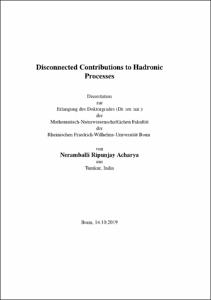Disconnected Contributions to Hadronic Processes

Disconnected Contributions to Hadronic Processes

| dc.contributor.advisor | Meißner, Ulf-G. | |
| dc.contributor.author | Acharya, Neramballi Ripunjay | |
| dc.date.accessioned | 2020-04-27T13:33:51Z | |
| dc.date.available | 2020-04-27T13:33:51Z | |
| dc.date.issued | 06.01.2020 | |
| dc.identifier.uri | https://hdl.handle.net/20.500.11811/8253 | |
| dc.description.abstract | Lattice quantum chromodynamics (QCD) is a powerful tool to calculate the dynamics of low-energy, non-perturbative QCD. It has made great strides in numerically evaluating hadronic observables by simulating the interactions of quarks and gluons on a lattice in finite volume. However, the evaluation of disconnected diagrams, which are Wick contraction diagrams containing quark propagators beginning and ending at the same time coordinates, has consistently proven to be a challenge. These diagrams have a low signal-to-noise ratio, and extracting the discrete energy shifts from the simulations of these diagrams is consequently either diffcult, expensive or both. In this thesis, we devise a way of separating, analysing and evaluating the different connected and disconnected diagrams contributing to the process of ππ scattering. We use partially quenched chiral perturbation theory, an effective field theory of the enlarged, partially quenched QCD to perform this separation of connected and disconnected diagrams. This procedure is inherently unphysical, and requires the trick of partial quenching wherein extra, unphysical quarks are added to QCD. Using the extra mesons that are generated by these quarks, we construct single-channel amplitudes for the individual connected and disconnected diagrams. We derive fully analytical expressions for their scattering lengths and effective ranges. These expressions are then used to accurately determine certain unphysical low-energy constants, which are fed back into the Lüscher equation to provide concrete, numerical predictions of energy shifts of certain combinations of the connected and disconnected diagrams. These predictions are stringent bounds that any future lattice collaboration studying ππ scattering must adhere to. This thesis thus provides an exemplary formalism to study disconnected contributions in various hadronic processes, and displays the benefits of the interplay between effective field theory and lattice QCD studies. | en |
| dc.language.iso | eng | |
| dc.rights | In Copyright | |
| dc.rights.uri | http://rightsstatements.org/vocab/InC/1.0/ | |
| dc.subject.ddc | 530 Physik | |
| dc.title | Disconnected Contributions to Hadronic Processes | |
| dc.type | Dissertation oder Habilitation | |
| dc.publisher.name | Universitäts- und Landesbibliothek Bonn | |
| dc.publisher.location | Bonn | |
| dc.rights.accessRights | openAccess | |
| dc.identifier.urn | https://nbn-resolving.org/urn:nbn:de:hbz:5-56968 | |
| ulbbn.pubtype | Erstveröffentlichung | |
| ulbbnediss.affiliation.name | Rheinische Friedrich-Wilhelms-Universität Bonn | |
| ulbbnediss.affiliation.location | Bonn | |
| ulbbnediss.thesis.level | Dissertation | |
| ulbbnediss.dissID | 5696 | |
| ulbbnediss.date.accepted | 04.12.2019 | |
| ulbbnediss.institute | Mathematisch-Naturwissenschaftliche Fakultät : Fachgruppe Physik/Astronomie / Helmholtz-Institut für Strahlen- und Kernphysik (HISKP) | |
| ulbbnediss.fakultaet | Mathematisch-Naturwissenschaftliche Fakultät | |
| dc.contributor.coReferee | Guo, Feng-Kun |
Dateien zu dieser Ressource
Das Dokument erscheint in:
-
E-Dissertationen (4383)




